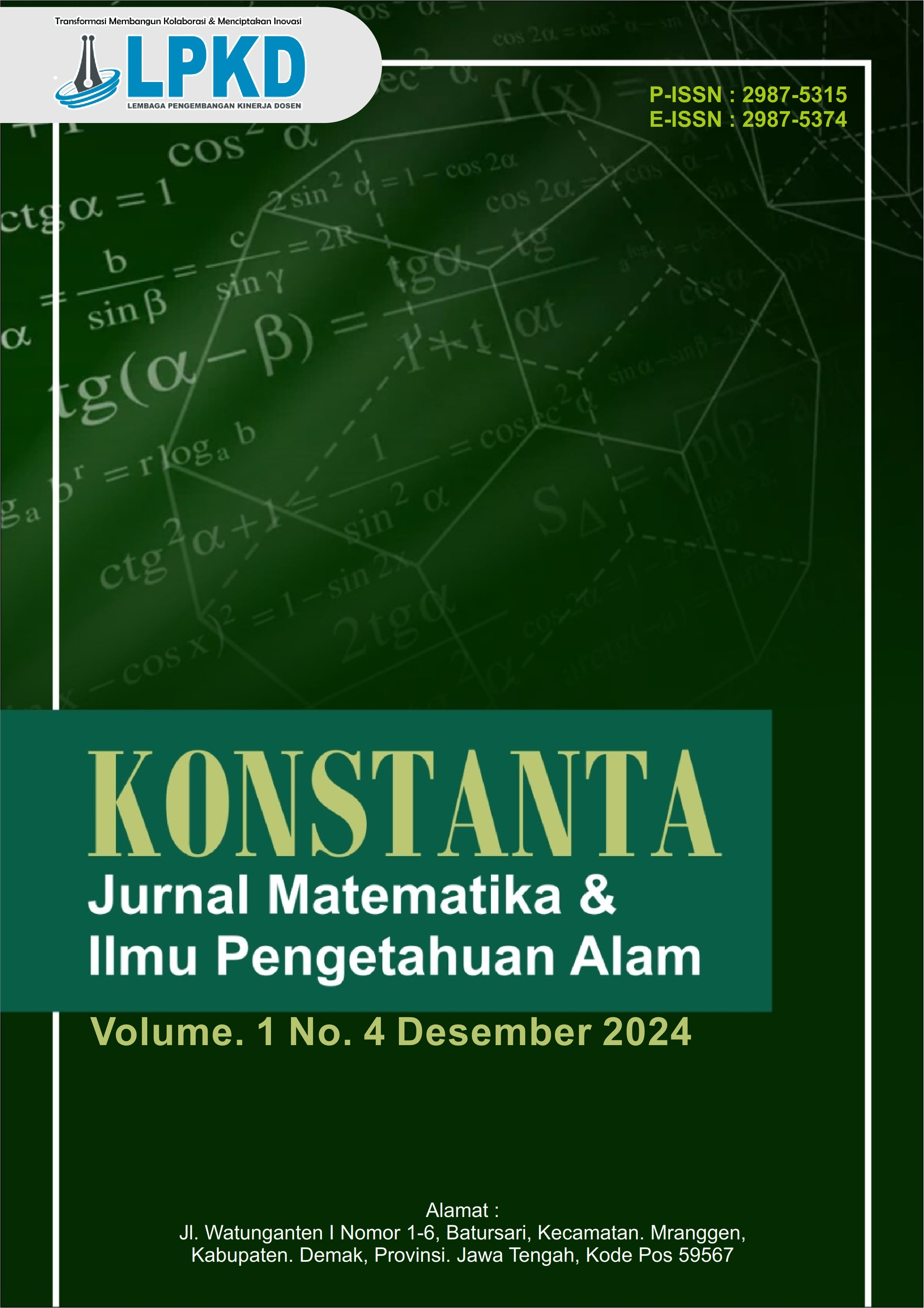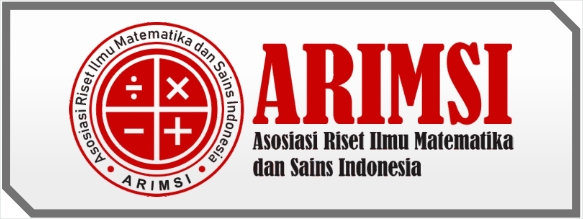Pengaruh Model pembelajaran Contextual Teaching And Learning (CTL) Terhadap Kemampuan Pemecahan Masalah Matematis Siswa Kelas VIII SMP Negeri 5 Pematangsiantar Pada Materi Sistem Persamaan Linear Dua Variabel
DOI:
https://doi.org/10.59581/konstanta.v1i4.1550Keywords:
Contextual Teaching and Learning learning model,, Mathematical Problem Solving, Material on Systems of Linear Equations in Two VariablesAbstract
This research aims to describe and analyze the mathematical problem solving abilities of class VIII students at SMP Negeri 5 Pematangsiantar on two-variable linear equation systems material, with treatment in the form of a Contextual Teaching And Learning (CTL) learning model. The approach taken in this research is a quantitative approach. Sampling was carried out using a simple random sampling technique. The research subjects were class VIII-6, totaling 30 people. The data collection technique in this research is in the form of a test to determine students' mathematical problem solving abilities in the research process carried out. Data analysis techniques were carried out using normality tests and hypothesis tests. From the results of data analysis, the results of students' mathematical problem solving abilities showed that the average pre-test score was 54336 and the average post-test score = 79,400. A significant value (2-tailed) 0.000 < 0.05 indicates that there is a significant difference between the initial and final variables. Thus, the independent variable has a significant effect on the dependent variable. So it can be concluded that by applying the Contextual Teaching And Learning CTL learning model) it can improve the mathematical problem solving abilities of class VIII students at SMP Negeri 5 Pematangsiantar on the material of two-variable linear equation systems.
References
Ana Ari Wahyu Suci & Abdul Haris Rosyidi. (2013). Kemampuan Pemecahan Masalah Matematika Siswa Pada Pembelajaran Problem Posing Berkelompok. MATHEdunesa, 1(2).
Apriyani, F., & Imami, A. I. (2022). Kemampuan Pemecahan Masalah Matematis Pada Siswa SMK Ditinjau Dari Kecemasan Matematika. Jurnal Educatio FKIP UNMA, VIII, 236-246.
Ardiantari, N. P., Wiarta, I., & Manuaba, I. B. (2015). Penerapan Pendekatan Saintifik dengan Penilaian Proyek untuk Meningkatkan Kemampuan Pemecahan Masalah dan Hasil Belajar Pengetahuan Matematika Tema Cita - Citaku Siswa Kelas IVB SD N 8 Pemecutan. MIMBAR PGSD Undiksha, 3, 1.
Arikunto, S. (2010). Prosedur Penelitian Suatu Pendekatan Praktik. Jakarta: Rineka Cipta.
Fatimah, A. E. (2016). PENINGKATAN KEMAMPUAN PEMECAHAN MASALAH MATEMATIS DAN KEMANDIRIAN BELAJAR SISWA SMK N 1 PERCUT SEI TUAN MELALUI PENDEKATAN DIFFERENTIATED INSTRUCTION. MES (Journal of Mathematics Education and Science), II, 2528-4363.
Hamzah, A. (2014). Evaluasi Pembelajaran Matematika. Jakarta: PT Raya Grafindo Persada.
Jaya, I. (2019). Penerapan Statistik untuk Penelitian Pendidikan. Jakarta: Prenada Media.
Laili, Husnul. (2016). Pengaruh Model Pembelajaran CTL dalam Meningkatkan Kemampuan Pemecahan Masalah Matematika Siswa MTs Nurul Hakim Kediri Ditinjau dari Segi Gender. Jurnal Studi Keislaman Dan Ilmu Pendidikan, 5 (2).
Laili, H. (2016). Pengaruh Model Pembelajaran Contextual Teaching and Learning (CTL) dalam Meningkatkan Kemampuan Pemecahan Masalah Matematika Siswa MTs Nurul Hakim Kediri Ditinjau dari Segi Gender. PALAPA, 4(2), 34–52. https://doi.org/10.36088/palapa.v4i2.22
Lestari, W. (2017). Pengaruh Model Pembelajaran Connected Mathematic Project terhadap Kemampuan Pemecahan Masalah Matematika. JKPM (Jurnal Kajian Pendidikan Matematika), 2(2), 245–253.
Mas'ula, S. (2013). Studi Kasus Tentang Kemampuan Pemecahan Masalah Matematis Siswa Kelas V Di Salah Satu SD Swasta Kota Bandung. S2 thesis, 6-7,96-97.
Norhayati, Hasanuddin, dan Hartono. (2018). Pengembangan Media Pembelajaran Berbasis Contexctual Teaching and Learning Untuk Memafasilitasi Kemampuan Pemecahan Masalah Matematis Siswa Madrasah Tsanawiyah. JURING, 1 (1).
Noviasari, E. (2021). The Effectiveness of Contextual Teaching Learning (CTL) on Problem Solving Ability in Mathematic Learning in The Pandemic Time Covid-19. January.
Sagala, Z. U., Simamora, Y., & Maharani, I. (2019). Pengaruh Model Pembelajaran Contextual Teaching And Learning terhadap Kemampuan Pemecahan Masalah Matematik. JMPM : Jurnal Matematika Dan Pendidikan Matematika, 2(2), 11–19.
Sugiyono. (2019). Metode Penelitian Kuantitatif. Bandung: ALFABETA, cv.
Sumartini, T. S. (2016). Peningkatan Kemampuan Pemecahan Masalah Matematis Siswa. Jurnal Pendidikan Matematika STKIP Garut, 1-6.
Suraji, S., Maimunah, M., & Saragih, S. (2018). Analisis KemampuanPemahaman Konsep Matematis dan Kemampuan Pemecahan Masalah Matematis Siswa SMP pada Materi Sistem Persamaan Linear DuaVariabel (SPLDV). Suska Journal of Mathematics Education, 4(1), 9. https://doi.org/10.24014/sjme.v4i1.5057
Susanto, Dian Oky Dan Sarkonah. (2014). Aplikasi (Contextual Teaching And Learning CTL) Untuk Meningkatkan Prestasi Belajar. Jakarta : PT Multazam Mulia Utama
Tangio, N. F. (2015, 09 01). UNG REPOSITORY. Retrieved 07 25, 2023, from repository.ung.id:https://repository.ung.ac.id/skripsi/show/411411094/deskripsi-kemampuan-pemecahan-masalah-matematika-pada-materi-soal-cerita-penjumlahan-dan-pengurangan-bilangan-bulat-di-kelas-vii-smp-negeri-1-tapa.html
Zuliyanti, P., & Pujiastuti, H. (2020). Model Contextual Teaching Learning ( CTL ) untuk Meningkatkan Kemampuan Pemecahan Masalah Matematis Siswa SMP. PRISMA, 9(1), 98–107.













